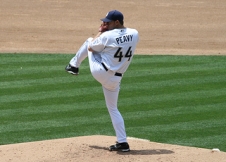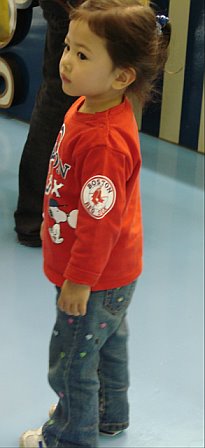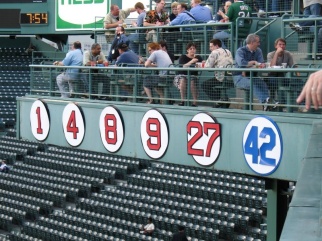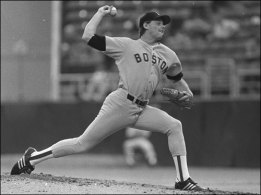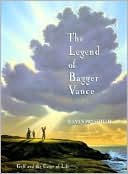 No time for sleep! Even though our bodies were craving some shut-eye, the Red Sox Nation crazies from the U.S. who are here in Japan boarded a bus at 5:30pm Sunday night (that’s 4:30am on Easter Sunday back home) to go see a ballgame.
No time for sleep! Even though our bodies were craving some shut-eye, the Red Sox Nation crazies from the U.S. who are here in Japan boarded a bus at 5:30pm Sunday night (that’s 4:30am on Easter Sunday back home) to go see a ballgame.
On the bus, I sat next to Deanne from Melrose, an E.R. nurse at a hospital just outside of Boston and a single mom, who said she made a “spur of the moment decision to take a vacation and come to Opening Day in Japan.” Before we could have a real conversation, though, the bus was invaded by a TV crew from Tokyo’s TBS network and a bubbly young Japanese reporter wearing Red Sox gear and a lot of make-up. She asked us questions about our fanhood in broken English and before long we were chanting “Let’s Go Red Sox!” and yelling “Red Sox are number one!” in Japanese (she taught us these words). She even got us to sing a verse of “Sweet Caroline,” a song that she said is also very popular in Japan.
(At midnight last night, I caught the ten-minute piece TBS did on the Red Sox’ visit to Tokyo, and the first image was of yours truly jubilantly walking off the bus at the Tokyo Dome. It’s wild to see yourself on Japanese TV.)
Walking from the bus to the game, someone in our group reflected, “You know how we always see big groups of Japanese tourists roaming the streets of Boston? Well, that’s us.”
 Once we got through the tight security at the Dome (close examination of everything in our bags and individual encounters with a metal-detecting wand), we found our seats just beyond third base, about halfway up, and settled in. I was fortunate to sit next to Red Sox Nation members who had come to Tokyo on their own, from very, very far away. To my right was Chris, who flew to Tokyo from his home in Thailand. Chris spent four years at Boston University and reflected that this was his first Red Sox game since 2001. “Only Wakefield and Varitek are left from the last team I cheered for at Fenway.”
Once we got through the tight security at the Dome (close examination of everything in our bags and individual encounters with a metal-detecting wand), we found our seats just beyond third base, about halfway up, and settled in. I was fortunate to sit next to Red Sox Nation members who had come to Tokyo on their own, from very, very far away. To my right was Chris, who flew to Tokyo from his home in Thailand. Chris spent four years at Boston University and reflected that this was his first Red Sox game since 2001. “Only Wakefield and Varitek are left from the last team I cheered for at Fenway.”
To my left was Dalton Maine, whose plane from Chicago had gotten him to Tokyo just in time for this game. Before settling in Chicago, he grew up in Framingham and played minor league baseball in the Orioles’ organization. (With some probing, I learned he struck out Vladimir Guerrero, Miguel Tejada, and Frank Thomas at different times in his pro career.) Dalton was there with his mom, Billie Maine, who recalled taking Dalton to his first game at Fenway when he was a little boy. “A player threw him a ball, and then he expected to get a ball at every game after that.” The player, Dalton informed me, was Royals pitcher Dennis Leonard.
When Dalton saw that I was taking notes about aspects of Japanese baseball that are different from Major League Baseball, he was very helpful in adding to my list. Here are some of our observations:
 1. The Japanese are obsessive about safety. 20-foot high nets line the first and third base lines (making it impossible for a fan to get hit by a low line drive); there are 2-3 rows of seats in front of these nets, and all children in these rows are required to wear a baseball helmet; the bat boys and ball boys wear helmets too and behave much more like Wimbledon ball boys, sprinting on and off the field like lightning bugs.
1. The Japanese are obsessive about safety. 20-foot high nets line the first and third base lines (making it impossible for a fan to get hit by a low line drive); there are 2-3 rows of seats in front of these nets, and all children in these rows are required to wear a baseball helmet; the bat boys and ball boys wear helmets too and behave much more like Wimbledon ball boys, sprinting on and off the field like lightning bugs.  Every time foul ball lands in the crowd, the loudspeakers make a “ding-dong” sound, and the message, “Please watch out for batted balls” flashes on the scoreboard. (It’s funny when there are 3 or 4 foul balls in a row, and this message is flashed over and over.)
Every time foul ball lands in the crowd, the loudspeakers make a “ding-dong” sound, and the message, “Please watch out for batted balls” flashes on the scoreboard. (It’s funny when there are 3 or 4 foul balls in a row, and this message is flashed over and over.)
2. I heard that Japanese fans are rabid and crazy, but here’s what I saw: there are about 200 fans (many wearing orange, others wearing yellow scarves, all banging drums) in the right field seats who sing and chant constantly, reminding me very much of the college football fans of Clemson University, and the rest of the stadium is virtually silent during most of the game. I am not exaggerating when I tell you that it’s as quiet as the first tee at the  Masters prior to every pitch (unless the cheerleaders in right field haven’t finished their song yet). It’s not that fans are not allowed to make noise, but whereas there’s positive pressure at Fenway to yell, “Come on, Papi!”, at the Tokyo Dome, you’d be the only one doing so. (And when I did, I’m sure Papi could hear me loud and clear from 150 feet away.) And the fans never stand up, except when there’s a home run (thank you, J.D. Drew and Jed Lowrie).
Masters prior to every pitch (unless the cheerleaders in right field haven’t finished their song yet). It’s not that fans are not allowed to make noise, but whereas there’s positive pressure at Fenway to yell, “Come on, Papi!”, at the Tokyo Dome, you’d be the only one doing so. (And when I did, I’m sure Papi could hear me loud and clear from 150 feet away.) And the fans never stand up, except when there’s a home run (thank you, J.D. Drew and Jed Lowrie).
3. The stadium is ultra-clean. When I told Dalton I imagined we could eat our dinner off the floor, he said, “Are you kidding? I’d rather have surgery on this floor than in a Chicago E.R.” I went to the bathroom for the first time in the 7th inning, and it had obviously just been cleaned minutes before. Either that, or no one else had used it before the 7th inning, either.
4. The hot dogs they sell in the stands are all individually wrapped in elegant cellophane envelopes. Quite a contrast to the (delicious) Fenway Franks that are removed from the mysterious, oily water and placed in buns before our very eyes back home.
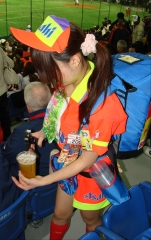 5. Beer is sold in the stands by girls wearing short skirts who appear to be between the ages of 15 and 21, and they carry very heavy canvas kegs on their backs, fill a cup, and hand it to you. A Japanese native explained to me that, to become a beer vendor, you have to pass a vigorous physical test. (Oh, and they also sell little bottles of hard alcohol.) All vendors are just about the most polite people you have ever met. And there’s a rule that vendors are only allowed to sell to the section on their right — so even if you’re sitting next to a vendor on the end of an aisle to her left, she can’t serve you unless she runs up her aisle and down another aisle to put you on her right. I’m sure there’s a good reason for this, but man, if this policy were implemented at Fenway, there’d be a revolution in the bleachers before the end of the top of the 1st inning.
5. Beer is sold in the stands by girls wearing short skirts who appear to be between the ages of 15 and 21, and they carry very heavy canvas kegs on their backs, fill a cup, and hand it to you. A Japanese native explained to me that, to become a beer vendor, you have to pass a vigorous physical test. (Oh, and they also sell little bottles of hard alcohol.) All vendors are just about the most polite people you have ever met. And there’s a rule that vendors are only allowed to sell to the section on their right — so even if you’re sitting next to a vendor on the end of an aisle to her left, she can’t serve you unless she runs up her aisle and down another aisle to put you on her right. I’m sure there’s a good reason for this, but man, if this policy were implemented at Fenway, there’d be a revolution in the bleachers before the end of the top of the 1st inning.
It’s interesting to note that, although alcohol (of all kinds) is so readily available and freely imbibed at the Tokyo Dome, there is not a shred of drunken behavior in the stadium. Can you imagine attending a game at Fenway Park and not seeing anyone who has had too much to drink? Being at Tokyo Dome last night made me realize just how accustomed we have become to the “bar atmosphere” at Fenway (and they don’t even sell beer in the aisles there).
 6. When the Yomiuri Giants are in the field (and the Red Sox are at bat), all of the Giants’ bench players run out to foul territory in deep right field. They do calisthenics, active stretching, practice their swings (without a bat), and just stay physically active the entire half-inning. When their teammates get the third out, they all sprint back to the dugout and sit down on the bench. These Japanese guys are READY to take the field at any moment, and they are FOCUSED on playing baseball every minute of the game. (As opposed to the typical bench player in the U.S. who, according to Dalton, “Sits there for a couple of hours chewing sunflower seeds, shooting the breeze with his buddy.”)
6. When the Yomiuri Giants are in the field (and the Red Sox are at bat), all of the Giants’ bench players run out to foul territory in deep right field. They do calisthenics, active stretching, practice their swings (without a bat), and just stay physically active the entire half-inning. When their teammates get the third out, they all sprint back to the dugout and sit down on the bench. These Japanese guys are READY to take the field at any moment, and they are FOCUSED on playing baseball every minute of the game. (As opposed to the typical bench player in the U.S. who, according to Dalton, “Sits there for a couple of hours chewing sunflower seeds, shooting the breeze with his buddy.”)
 7. Under the stadium seats on the concourse, there are three small, glass “smoking rooms” that are jammed with fans staring up at the large flat screen TV through a thick, white fog. When the door opens and a fan enters or leaves, huge clouds billow through the doorway.
7. Under the stadium seats on the concourse, there are three small, glass “smoking rooms” that are jammed with fans staring up at the large flat screen TV through a thick, white fog. When the door opens and a fan enters or leaves, huge clouds billow through the doorway.
8. In the later innings, the Giants sent a pinch-hitter to the plate, and clearly it was his big day, because the fans broke out singing “Happy Birthday” to the player as he stood in the batter’s box. It’s clearly a tradition here to help players celebrate their birthday. “Friendly Fenway” isn’t quite there yet.
9. Generally, the Tokyo Dome uses the same cheering tunes we do in the U.S. (If I could hum them to you in this blog, you’d know them all.) But the voice that said “Charge!” at the end of that familiar trumpet blast could not have been mellower. And these fans get into “Y.M.C.A.” with the best of U.S. fans. When the popular song was blared in between innings, Japanese fans were standing, contorting their bodies into the letters as the song went along. The Japanese version of the song (which is not sung by the Village People) has them yelling, “Gimme a Y, gimme an M, gimme a C, gimme an A!” Is it not truly incredible that this song has infiltrated the culture of the world so thoroughly??
 10. Speaking of music, we were treated to “Sweet Caroline” in the 8th inning, and “Dirty Water” coursed through the stadium after the Sox had won (do you think The Standells received some royalties in yen last night?). I have to say, while I was impressed to see so many Sox fans singing Sweet Caroline at the top of their lungs, the song was definitely not as much fun for me to sing away from Fenway and without my kids being there with me. In fact, I think we might want to create a rule in Red Sox Nation against singing the song in large groups outside Fenway Park. It’s really not even close to being the same experience away from home (and away from my children, too).
10. Speaking of music, we were treated to “Sweet Caroline” in the 8th inning, and “Dirty Water” coursed through the stadium after the Sox had won (do you think The Standells received some royalties in yen last night?). I have to say, while I was impressed to see so many Sox fans singing Sweet Caroline at the top of their lungs, the song was definitely not as much fun for me to sing away from Fenway and without my kids being there with me. In fact, I think we might want to create a rule in Red Sox Nation against singing the song in large groups outside Fenway Park. It’s really not even close to being the same experience away from home (and away from my children, too).
11. Like at Fenway, there were a lot of kids in the Tokyo Dome, and also like at Fenway, many of them were wearing Red Sox t-shirts. Of course, 75% of them were Matsuzaka and Okajima shirts, but I saw several Japanese kids around 10-12 years old wearing Ramirez and Ortiz shirts. Curiously, I don’t think I saw a single little girl at the game, except for the beer vendors.
12. Finally, the place truly came ALIVE when Hideki Okajima took the mound in relief. These Japanese fans ADORE the Major League players f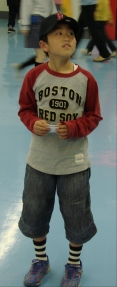 rom their homeland. Now, this just was an exhibition game in March, but there were more flashbulbs going off for every pitch he made, and every pickoff throw to first base, than if it were the first pitch of the 7th game of the World Series. It was as if Babe Ruth himself had risen from the grave and was pitching for the first time in a century. The fan behind me quipped, “It’s like flashbulb spam.”
rom their homeland. Now, this just was an exhibition game in March, but there were more flashbulbs going off for every pitch he made, and every pickoff throw to first base, than if it were the first pitch of the 7th game of the World Series. It was as if Babe Ruth himself had risen from the grave and was pitching for the first time in a century. The fan behind me quipped, “It’s like flashbulb spam.”
I missed the bus that brought us back to the hotel because I stayed at the Tokyo Dome a bit longer than others did to take a few more photos. So I took a cab (which, like all other cabs in Japan, was immaculate on the outside and inside) and arrived back here around 11:30pm Tokyo time. Walking to the elevators in an oddly quiet and deserted lobby, I suddenly noticed three men sitting at a small table, talking casually. There was David Ortiz wearing a black leather jacket and dark sunglasses. We made eye contact. I instinctively offered a “hello” gesture. He waved back.
He’s seen me in the lobby twice now. We’re pals.
 So Manny finally connected for his 500th career home run (and then his 501st, 502nd, and 503rd). Only 24 people in major league history have achieved this milestone. That’s one of the marvelous things about baseball — performance is so quantifiable. We KNOW that Manny Ramirez is one of the greatest 24 home run hitters of all-time. It’s simply not debatable.
So Manny finally connected for his 500th career home run (and then his 501st, 502nd, and 503rd). Only 24 people in major league history have achieved this milestone. That’s one of the marvelous things about baseball — performance is so quantifiable. We KNOW that Manny Ramirez is one of the greatest 24 home run hitters of all-time. It’s simply not debatable.







































